 Petzlover
Petzlover Canis Panther is originated from United States but Norfolk Terrier is originated from United Kingdom. Canis Panther may grow 51 cm / 21 inches higher than Norfolk Terrier. Canis Panther may weigh 59 kg / 131 pounds more than Norfolk Terrier. Canis Panther may live 3 years less than Norfolk Terrier. Both Canis Panther and Norfolk Terrier has almost same litter size. Canis Panther requires Low Maintenance. But Norfolk Terrier requires Moderate Maintenance
Canis Panther is originated from United States but Norfolk Terrier is originated from United Kingdom. Canis Panther may grow 51 cm / 21 inches higher than Norfolk Terrier. Canis Panther may weigh 59 kg / 131 pounds more than Norfolk Terrier. Canis Panther may live 3 years less than Norfolk Terrier. Both Canis Panther and Norfolk Terrier has almost same litter size. Canis Panther requires Low Maintenance. But Norfolk Terrier requires Moderate Maintenance
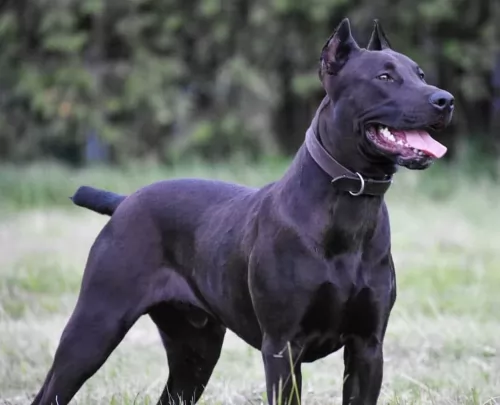 The Canis Panther is a strong, muscled dog who has been developed in the USA in the 1970s by Scorpio Jones, Michael Stratten, and Lucas Lopez. They mixed the Doberman Pinscher, the Great Dane the Labrador Retriever and the American Staffordshire Bull Terrier.
The Canis Panther is a strong, muscled dog who has been developed in the USA in the 1970s by Scorpio Jones, Michael Stratten, and Lucas Lopez. They mixed the Doberman Pinscher, the Great Dane the Labrador Retriever and the American Staffordshire Bull Terrier.
This dog hasn’t got a long history, having only been established in the 1970's, but the breeders wanted a dog much like the Doberman but somewhat larger and stronger. It is a dog breed which is still fairly unknown in the United States and elsewhere.
 It was in the 1880s that a working terrier was developed in eastern England. The Norfolk Terrier was developed by crossing local terrier-like dogs with the Irish Terrier breed as well as small red terriers.
It was in the 1880s that a working terrier was developed in eastern England. The Norfolk Terrier was developed by crossing local terrier-like dogs with the Irish Terrier breed as well as small red terriers.
Known first as the Cantab Terrier and then later as the Trumpington Terrier, the name changed further but in 1932, the Norwich was accepted into the English Kennel Club and the first written standard was created.
The Norfolk Terrier was recognized by the United Kennel Club in 1979. It has gained recognition as an independent breed but is a variety of the Norwich Terrier, distinguished from it by having floppy ears and not erect ears. Both the Norfolk- and Norwich are the smallest of the working terriers.
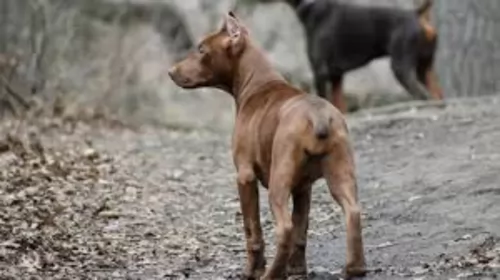 The Canis Panther is a large dog measuring roughly 68 – 77 cm in height and weighing around 50 to 63 kg. He has a deep chest and strong neck. The coat is short and dense and it is is essentially a solid color - fawn, grey, blue, chocolate or black.
The Canis Panther is a large dog measuring roughly 68 – 77 cm in height and weighing around 50 to 63 kg. He has a deep chest and strong neck. The coat is short and dense and it is is essentially a solid color - fawn, grey, blue, chocolate or black.
He looks magnificent with his cropped ears and short docked tail. Unfortunately with regulations surrounding the docking of dog’s tails, the dog these days is often left with a long tail.
He is an intelligent, territorial dog and makes an excellent watchdog. He is a dog which can be easily trained and socialized and then he makes a great family dog. He is loving and loyal to his human family, being somewhat aloof with strangers. His gets along well with children in the home as well as with other pets.
 The Norfolk Terrier is a small purebred dog, standing at 23 to 25cm in height and weighing roughly between 4.5kg and 6kg. The dog has a wire-haired coat which can be in different colors such as wheaten, red, black and grey or grizzle.
The Norfolk Terrier is a small purebred dog, standing at 23 to 25cm in height and weighing roughly between 4.5kg and 6kg. The dog has a wire-haired coat which can be in different colors such as wheaten, red, black and grey or grizzle.
The hair on his head and ears is shorter and smoother and he has longer whiskers and eyebrows. The chest is deep, the front legs are short and straight and the tail has always been docked to half its length but left long these days. The tail is set high and carried erect.
Norfolks are feisty, fearless dogs with an independent streak. They’re gentle though, and when it comes to being a companion dog, they get on well with children and other pets. They thrive on their human family’s companionship and wouldn’t do well at all if they were constantly left outside.
They’re not yappy dogs but will bark occasionally so he can sound the alarm if strangers approach.
This little dog is able to live in the city or the countryside, but just because he is little, you can’t neglect his exercise needs. He will most certainly need to be exercised every day and taken for walks as he is an energetic, lively dog. He is intelligent too and easy to train and socialize, turning him into such an obedient, pleasurable pet.
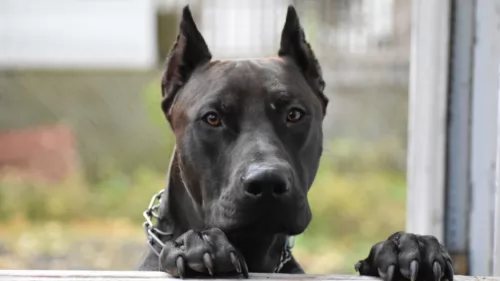 The Canis Panther is a loving dog in spite of his large, guard-dog looks. He is intelligent, bold and courageous, and when trained and socialized is a devoted, loyal, loving pet.
The Canis Panther is a loving dog in spite of his large, guard-dog looks. He is intelligent, bold and courageous, and when trained and socialized is a devoted, loyal, loving pet.
He is known for his high intelligence and becomes so attached to his human family he will fight to the death for them if needs be. He is a territorial dog and won’t welcome strangers to his door.
The Canis Panther puppy is outgoing and playful, loving the company of kids in the family.He requires a firm owner who can see to it that he gets in a good quota of exercise. He is an energetic dog and if he isn’t given enough exercise he can become destructive and aggressive through no fault of his own but because of an irresponsible owner.
The Canis Panther is a large dog but given love and proper care he becomes the most awesome, strong devoted pet and protector.
 Fearless and brave, the Norfolk Terrier promises to be a wonderful companion.
Fearless and brave, the Norfolk Terrier promises to be a wonderful companion.
They're social, loving dogs and want to be part of the household. He is lively and active too and wants to be included in your walks and your games. He loves nothing more than to be running across a field after a ball.
They’re such amicable pets that they make great dogs for first-time dog owners. Let him into your heart and your home – he makes such a splendid pet – that once you’ve had one, you’ll realize you can never be without such a wonderful pet and companion again.
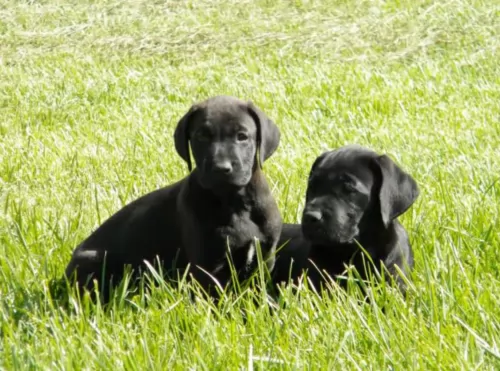 The Canis Panther breed is not known to have any particular illness and he can live to be 10, 11 or 12 years of age. However, like every other dog, there are some more common dog illnesses that you will need to be aware of and which are seen more commonly in larger dog breeds, some of which are -
The Canis Panther breed is not known to have any particular illness and he can live to be 10, 11 or 12 years of age. However, like every other dog, there are some more common dog illnesses that you will need to be aware of and which are seen more commonly in larger dog breeds, some of which are -
Larger breeds can be prone to bone cancer, known as Osteosarcoma and found more often in the limbs. Dogs develop swelling in the affected part of the limb and the bones can break easily. If you notice swelling or limping, see that you get your pet to the vet.
This is another kind of cancer which affects the Lymphocytes, a type of white blood cell. Dogs with Lymphoma may have an enlarged lymph node under the chin and neck for instance or the swelling could be in the groin area. Get your dog to the vet so as to have the lump biopsied.
 The life expectancy of your Norfolk Terrier is 8 to 14 years, but there are some who have received excellent care and who have reached 17 years of age.
The life expectancy of your Norfolk Terrier is 8 to 14 years, but there are some who have received excellent care and who have reached 17 years of age.
Just as with any other dog, they are prone to common dog illnesses, and these can include dental issues and mitral valve disease. They also are prone to hip dysplasia, and according to the Orthopedic Foundation for Animals (OFA) they are known for problematic hips.
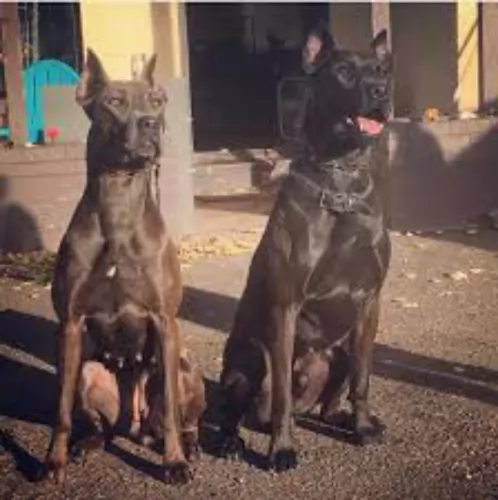 With his short coat, the Canis Panther is looked upon as a low mainenance dog. You’ll need to brush his hair at least twice a week though to remove loose hairs and keep the coat shiny.
With his short coat, the Canis Panther is looked upon as a low mainenance dog. You’ll need to brush his hair at least twice a week though to remove loose hairs and keep the coat shiny.
Brush your pet’s teeth at least 2 or 3 times a week. You get special toothpaste and toothbrush for dogs and your vet can guide you on how to use them. If you don’t attend to your pet's teeth, he can experience tartar build up. This can lead to gum disease and tooth loss. Not only that, bad teeth can affect other parts of the body too.
This breed comes from several large dog breeds and as a big dog, he is certainly going to need a good deal of exercise. He’ll need a walk every day or perhaps frisbee games in the park where he is made to run.
Any dog requires exercise, and especially a magnificent dog like this one. You want to make sure you maintain those lean, muscled limbs by ensuring he gets his fair share of exercise.
 The Norfolk Terrier’s hard, wiry, straight coat requires being hand stripped about twice a year by hand or with a stripping knife. The paws will also need to be trimmed.
The Norfolk Terrier’s hard, wiry, straight coat requires being hand stripped about twice a year by hand or with a stripping knife. The paws will also need to be trimmed.
It is recommended to keep the hair short around the anus for hygienic purposes and the tail itself will need to be stripped.
The Norfolk doesn’t shed his coat naturally, and the hair keeps growing, making the dog uncomfortable and ungroomed looking. The dog will certainly need to have his hair kept away from around the eyes.
If you don’t want to strip your dog, there are people who take their dogs to professional groomers, but then this professional grooming makes it that the texture of the dog’s coat changes from wiry to soft.
Small dogs are prone to dental problems, so check your dog’s teeth regularly. A bad tooth can play havoc with your dogs general health.
As with any other dog, the Norfolk Terrier will do well on high-quality kibble, specially formulated for small dog breeds. For a tasty treat, boil some chicken and vegetables such as sweet potato, carrots and spinach in a pot, chop them up and add to his kibble with some brown rice and pasta. A tiny bit of raw meat added in occasionally is all this little dog needs to stay healthy and content.
Don’t ‘treat’ him by giving him chocolates, chips and peanuts. You will upset his stomach. Dogs do best on simply, healthy, tasty diets such as mentioned above. Make sure he has a constant supply of fresh, cool water.